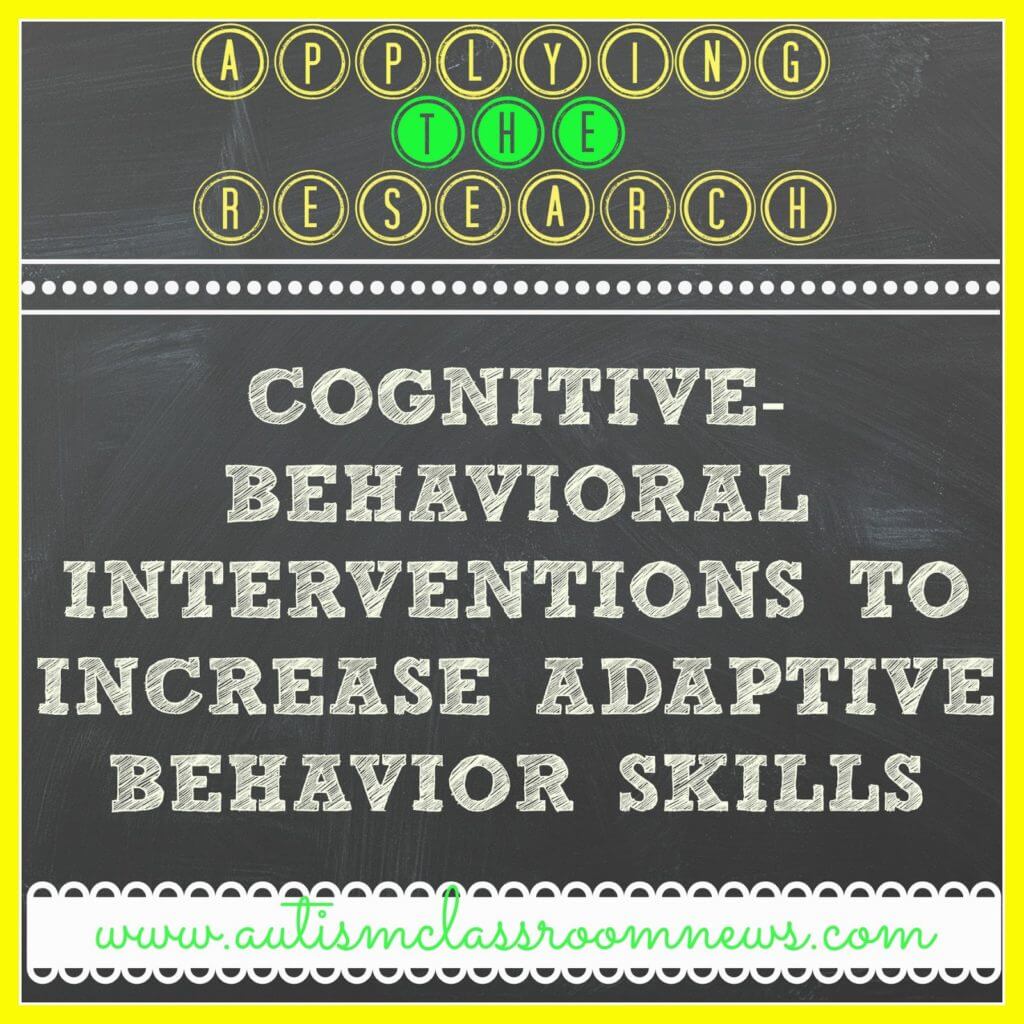Today we continue with the review of evidence-based practices for individuals with autism. This is the last installment on the application of cognitive-behavioral interventions. For earlier posts in the series, click HERE.
Cognitive-behavioral interventions have long been used to improve mood and address anxiety in a variety of populations and I’ve talked about how effective they are for some of our students with ASD. However, I wanted to highlight one of the research articles that was included in the National Professional Development Center’s review that surprised me. The idea that you could use CBTs, which essentially are aimed at addressing how people think or their inner scripts (private events and verbal behavior for those strict ABA folks), to change independent functioning. What an interesting concept that you could use these same strategies to improve a child’s outward implementation of skills like personal hygiene and chores around the house. Well that’s precisely what this article by Drahota, Wood, Sze, & Van Dyke (2011) did.
What They Did
Drahota et al. worked with families in the homes of children diagnosed with Asperger’s Disorder ages 7-11 years old. The premise of the study was that black-and-white or rigid attributions and potential anxieties were preventing the children from being more independent in the home. The focus of the intervention was to highlight increasing responsibility of the children and focusing on self-efficacy of independence. In other words, they helped the parents and the kids to talk about social norms and what other kids their age were doing around the house. They focused on the need to be responsible as part of the family, and they provided affirmations and positive statements of the expectation that the children could be successful. They also taught parents to provide positive “regard” (which certainly could have served as reinforcement) for each small step attempted (not necessarily only those achieved). They then worked with the children to reframe their self-talk or thoughts. So instead of saying, “I can’t do this because if I do, my mom won’t help me with anything ever again” (see that black and white thinking again?), they taught the children to use more positive, constructive self-statements (“Even if I do this by myself, my mom will probably help me with other things I need help with.”). Finally, they also focused on the parents and trained them to support the children’s independence through positive feedback (read: reinforcement) and communication and to convey the expectation that the child was capable of completing the chore.
What they found was that the daily living skills independence around the house increased. There was a correlation between that increase and a decrease in overall anxiety levels as well. So the kids were more independent and reported feeling better. Plus, the parents reported feeling more confident that their children could be independent.
Interpretation:
A couple of things we have to take into consideration. First, most of the reports of the child’s execution of skills came from the parents, who, because they were participants, were aware of the conditions and the intent of the intervention. Also, we don’t really know if they changed the “thoughts” of the participants so much as helped parents provide encouragement and reinforcement for attempts at completing the skills. Certainly having the parents expect more and communicate that more clearly to their children probably played a role. Having the parents notice that the child was trying (reinforcing attempts not just success) probably helped as well. These caveats are important for interpreting the research in part because we don’t really know what played an active role in the change in behavior. However, we do know that at least to some degree, this package worked. Different practitioners will probably interpret the elements a bit differently and that’s Ok. Rather than thinking about how it can be explained, let’s focus on what it can teach us.
Takeaway:
I think it’s important to recognize that sometimes the independence of a child is related to more than the ability to complete the skill. Clearly it’s associated with the context in which the skill is expected. This may account for some of the differences we see between children’s performance of skills at home or with mom in the classroom vs. what we see in the classroom. Different expectations of the settings may play a role. Keep in mind that mom has a longer history with the child than you do and that means a longer learning history of doing “for” the child instead of expecting him to do it on his own. As teachers, our role is different–our role is specifically to teach him to do it on his own. Most mothers who are teachers will tell you they do more for their own children than they would ever allow in the classroom. [That’s my long-winded way of saying teachers-don’t judge families; families-don’t judge teachers.]
Similarly, I think it shows that there are probably some underlying self-statements that could play a role in whether a child can be independently successful at something. In order to try something new or do it on your own, you (the child, me, you, all of us) have to believe that we can do it. We have to have confidence in our skills. We have to get rid of self-statements that say, “I’m not ready” and move to ones that assert that we can do it.
So, just think about that as the week progresses. How do you convey confidence to your students? How do you praise / reinforce skills that for them may be a big step (raising their hand to ask a question) and that for you may be just a little step (the larger goal is asking the question)? I’ve actually started writing in some behavioral support plans that we will give directions in a way that conveys confidence that the child can do what we ask (e.g., I can’t wait to see what you are going to write in your journal today! I am so impressed with your math skills. I know you can finish these up quickly!). If there is an anxiety issue about a skill, conveying confidence helps the child to meet that expectation. Think of it as the expectation of competence.
Reference:
Drahota, A.,
Wood, J. J., Sze, K.
M., & Van Dyke, M. (2011). Effects of cognitive behavioral therapy on daily
living skills in children with high-functioning autism and concurrent anxiety
disorders. Journal
of Autism and Developmental Disorders, 41(3), 257–265.
Until next time,









